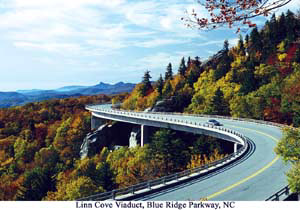|
Tar Heel
Travels
Blue Ridge Parkway
Why it took 52 years to complete
'America's most scenic drive'
By Bill F. Hensley
 It
is known around the world as “America’s most scenic drive,” and there is
little argument in bestowing that prestigious title on the famed Blue Ridge
Parkway, the spectacular route that traverses from Virginia through North
Carolina and connects two popular national parks. It
is known around the world as “America’s most scenic drive,” and there is
little argument in bestowing that prestigious title on the famed Blue Ridge
Parkway, the spectacular route that traverses from Virginia through North
Carolina and connects two popular national parks.
“I don’t know of a more beautiful drive anywhere on earth,” says veteran
travel writer Jim Wamsley of Richmond, Va. “It has everything: the majestic
blend of forest, mountain and waterfall; fascinating flora and fauna; a colorful
mountain heritage; places to stop and enjoy. Gaze from the overlooks. Hike into
the wilderness. Go camping. Take side trips. You will be overwhelmed, as I
always am.”
For the record, the Parkway stretches for 469 miles and covers 80,000 acres
along the rugged crests of towering mountains. It begins at the south entrance
of Shenandoah National Park and ends in Cherokee, where the Great Smoky
Mountains National Park begins.
The Parkway is as much a part of North Carolina as basketball and barbecue, and
its 22 million annual visitors make it the most visited of all national parks.
And it’s a moneymaker, as tourism generated $2 billion last year for the 18
western counties that use the thoroughfare as a major transportation artery.
“The Blue Ridge Parkway is a national treasure,” says Hugh Morton, the owner
of Grandfather Mountain, who played a key role in the road’s history and
development. “There’s never a day that I don’t thank the good Lord for
this priceless asset. Very few states can claim anything that comes close to
equaling the Parkway as a travel attraction.”
The idea of a picturesque drive along the state’s mountaintops originated in
1906 with a geologist named Joseph Pratt, who proposed a toll road from Marion,
Va., to Tallulah, Ga. After securing a charter for the Appalachian Highway Co.,
construction began in 1914 between Altapass and Pineola, N.C., but was brought
to a halt by the outbreak of World War I and was never resumed.
The chief inspiration for the Parkway came from the building of the Skyline
Drive through Shenandoah National Park. The depression-era project quickly
generated national publicity and interest, and when President Franklin D.
Roosevelt visited in 1933, he was urged to extend the route to the new Great
Smoky Mountains National Park. The president liked the suggestion and was backed
by the governors of North Carolina, Virginia and Tennessee.
Interior Secretary Harold Ickes approved the new highway as a public works
project and authorized $4 million in funds. After the routing had been approved,
landscape architect Stanley Abbott of New York was hired to direct the design
and planning. Work began in September 1935 on a 12-mile stretch near Cumberland
Knob in North Carolina.
Because of delays, the Parkway — officially named the Blue Ridge Parkway by
Congress in 1936— was divided into 45 separate construction units. The work
was done mostly by private contractors, but the Works Progress Administration
was involved in order to provide employment for as many men as possible. Workers
earned $55 a week.
When World War II started, construction funds were impounded and work came to a
halt. At the time, 170 miles had been finished and another 160 miles were
partially completed. The price tag stood at $20 million.
Post-war work was slow to resume because funds were limited, but by the
mid-1950s about half of the Parkway had been completed. Work moved faster during
the next decade, and at the end of 1966 only 7.7 miles remained unfinished. But
it took another twenty years, however, for the “missing link” on Grandfather
Mountain to be built and to complete the project after 52 years.
The argument over where to build the unfinished section was long, often heated
and emotional, and took place in federal and state government circles. Federal
engineers wanted to take the Parkway across the top of the privately owned
mountain, but Morton — the owner and an arch conservationist — and his avid
supporters rightfully declared that such a routing would require too much land
and would seriously damage the natural beauty of the terrain. They held out for
a “middle route” that would do minimum damage and be less costly, yet would
be in keeping with the integrity of the project.
Strongly backed by the administration of governors Luther Hodges, Terry Sanford
and Dan Moore, Morton finally won his intense battle, although the missing link
wasn’t completed until 1987.
Today, the stretch around Grandfather — highlighted by the architecturally
significant and award-winning Linn Cove Viaduct — is one of the Parkway’s
most spectacular sections and has drawn national acclaim for its superb
engineering and esthetic marvels.
The awesome natural beauty of this leisurely drive, preserved in all its glory,
is proof that man, nature and government can work in harmony.
For more information on the Blue Ridge Parkway, contact the National Park
Service or the Blue Ridge Parkway Association at P.O. Box 2136, Asheville, N.C.,
28802, or visit www.blueridgeparkway.org.
Return to
magazine index
|